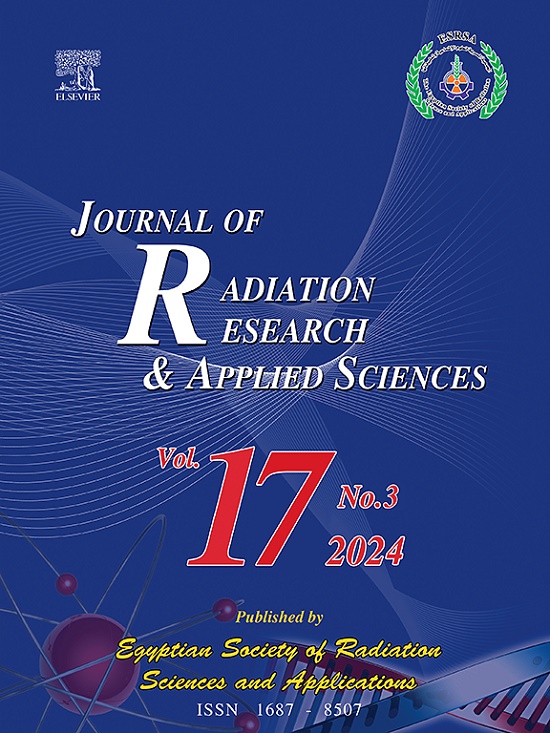Khellin a promising natural compound for alleviation of diabetic nephropathy: Evidence from in-silico, in-vitro and in-vivo studies
IF 1.7
4区 综合性期刊
Q2 MULTIDISCIPLINARY SCIENCES
Journal of Radiation Research and Applied Sciences
Pub Date : 2025-05-19
DOI:10.1016/j.jrras.2025.101590
引用次数: 0
Abstract
Objective
This study aimed to evaluate the potential impacts of Khellin (Khe) therapeutic potential in streptozotocin (STZ)-induced diabetic nephropathy (DN) using integrated in silico, in vitro, and in vivo approaches.
Methods
In silico studies were conducted to assess whether Khe could target DN-associated proteins. In vitro, the MTT assay assessed Khe's impact on normal kidney HK-2 cells. In vivo, male Sprague Dawley rats (n = 30) were randomly divided into six groups: normal control (Cnt), low (Khe-L, 50 mg/kg), and high (Khe-H, 100 mg/kg) dose Khe, DN, DN + Khe-L, and DN + Khe-H. Renal function markers, oxidative stress parameters, inflammatory cytokines, and apoptotic genes were evaluated. Histopathological examination of kidney tissues was also performed.
Results
Khe showed variable binding affinities and interaction patterns in a molecular docking study against seven proteins (TNFα, TGFβ1, ETS1, TIMP2, MAPK14, PI3K, and KIM1) involved in DN pathogenesis. In vitro, Khe improved the survival of high glucose (HG) treated HK-2 cells and inhibited the activation of MAPK14, PI3K, caspase 3, and TNFα induced by HG. Khe-treated rats (DN + Khe-L, and DN + Khe-H) exhibited significantly 1) decreased serum levels of creatinine, urea, and retinol-binding protein (RBP), 2) declined urinary proteins levels, 3) reduced renal levels of MDA, 4) increased activities of the antioxidant enzymes (SOD, CAT, GPx), 5) downregulated renal expression of TNFα, TGFβ1, ETS1, TIMP2, KIM1, MAPK14, PI3K, and Bax, and 6) upregulated expression of Bcl2 compared to the DN group. These biochemical and molecular results were corroborated by histopathological examination, which showed that the groups treated with Khe had much better kidney tissue integrity. The effectiveness of the treatment depended on the dosage.
Conclusion
Khe exhibited therapeutic effects in DN, potentially mediated by its antioxidant, anti-apoptotic, and anti-inflammatory mechanisms. These findings underscore Khe's promise as an adjunctive therapy for DN.
Khellin是一种有前景的减轻糖尿病肾病的天然化合物:来自计算机、体外和体内研究的证据
目的本研究旨在通过体内、体外和体内综合方法,评估Khellin (Khe)对链脲佐菌素(STZ)诱导的糖尿病肾病(DN)的潜在治疗潜力。方法通过硅片研究Khe是否能靶向dn相关蛋白。在体外,MTT试验评估Khe对正常肾HK-2细胞的影响。将30只雄性sd大鼠随机分为正常对照组(Cnt)、Khe、DN、DN + Khe- l、DN + Khe- h低剂量组(50mg /kg)、Khe- h高剂量组(100mg /kg)。评估肾功能指标、氧化应激参数、炎症因子和凋亡基因。同时进行肾组织病理检查。结果skhe在与DN发病相关的7个蛋白(TNFα、TGFβ1、ETS1、TIMP2、MAPK14、PI3K和KIM1)的分子对接研究中显示出不同的结合亲和力和相互作用模式。在体外实验中,Khe提高了高糖(HG)处理的HK-2细胞的存活率,抑制了HG诱导的MAPK14、PI3K、caspase 3和TNFα的活化。Khe处理大鼠(DN + Khe- l和DN + Khe- h)表现出1)血清肌酐、尿素和视黄醇结合蛋白(RBP)水平降低,2)尿蛋白水平下降,3)肾脏MDA水平降低,4)抗氧化酶(SOD、CAT、GPx)活性升高,5)肾脏TNFα、TGFβ1、tgf - β1、tgf - β1的表达下调。与DN组相比,ETS1、TIMP2、KIM1、MAPK14、PI3K和Bax表达上调,6)Bcl2表达上调。组织病理学检查证实了这些生化和分子结果,表明Khe治疗组肾脏组织完整性好得多。治疗的效果取决于剂量。结论khe具有抗氧化、抗凋亡、抗炎等治疗DN的作用。这些发现强调了Khe作为DN辅助治疗的前景。
本文章由计算机程序翻译,如有差异,请以英文原文为准。
求助全文
约1分钟内获得全文
求助全文
来源期刊

Journal of Radiation Research and Applied Sciences
MULTIDISCIPLINARY SCIENCES-
自引率
5.90%
发文量
130
审稿时长
16 weeks
期刊介绍:
Journal of Radiation Research and Applied Sciences provides a high quality medium for the publication of substantial, original and scientific and technological papers on the development and applications of nuclear, radiation and isotopes in biology, medicine, drugs, biochemistry, microbiology, agriculture, entomology, food technology, chemistry, physics, solid states, engineering, environmental and applied sciences.
 求助内容:
求助内容: 应助结果提醒方式:
应助结果提醒方式:


